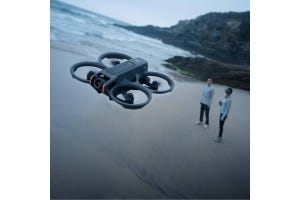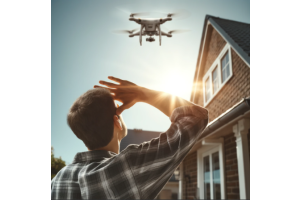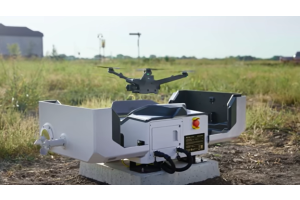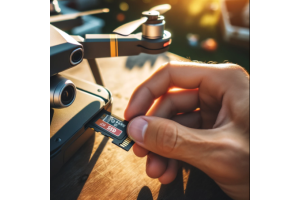In case you missed the webinar, we’ve got it for you right here!
On June 30, 2017, we completed our Aerial Thermal Imaging Fundamentals webinar. This was to help people reach a very basic understanding of thermal imaging from a drone.
Our Q&A section was open throughout the entire webinar, as well as a Q&A section at the end.
DSLRPros’ Head of Product Development, Robert Scott, lead the webinar and put together a list of questions asked during the presentation, Q&A, and a couple of extra questions that he gets on a regular basis.
1. How Long is the lead time for a thermal camera?
For shops that DON’T stock thermal cameras lead times can take between 4 & 5 weeks. We stock all of the most popular configurations and delivery can be 1-2 weeks depending on if you require a custom built solution.
2. Do you offer financing for all of your solutions?
We have great financing programs designed to support small to medium businesses, startups as well as established businesses. Our financing options feature low monthly payment terms between 12 to 60 months, 100% Tax deductible payments and lines of credit to help your business grow.
3. Does the FLIR Tools software work on a MAC?
Yes, FLIR Tools is available for MAC users. A link to the download in the Apple iTunes store can be found here: https://itunes.apple.com/us/app/flir-tools/id579348845?mt=12
4. How does the Stork Payload Drop system work on the Inspire 1?
The Stork payload drop system is a pair of fixed mechanical arms that take advantage of the built-in landing gear action on the Inspire 1 and is rated to hold roughly 800 grams. With the landing gear in a “Down” position the arms are closed and “Locked”, once you switch the landing gear to the “Up” position the arms are then opened or “Disengaged” Link found here: https://www.dslrpros.com/skyzimir-stork-payload-drop-system.html
5. Can thermal be used for outdoor searches in wooded areas?
Yes, thermal cameras have the ability to see through canopies and can be used for search and rescue operations in wooded areas. This can, however, vary on a few factors like how high you are flying and how thick the canopies are. Please submit a consultation request and one of our solutions specialists can provide a few examples of this directly.
6. Is the Zenmuse XT compatible with the OSMO?
Unfortunately, no. Designing a product to be used on an airborne platform has drastically different requirements. For example, the Zenmuse XT has been designed for aerial applications which means it must be extremely light to maximize flight times. In contrast, a FLIR handheld product is designed for accidental drops and ruggedized for use on the ground and in the field which adds significant weight to the overall design.
7. Will the Zenmuse XT work on a Phantom platform?
Unfortunately, no. The Zenmuse XT requires a platform with higher payload carrying capacity like the Inspire 1 and Matrice Series product lines. There are some alternative solutions and highly recommend submitting a free consultation request with one of our solutions specialists.
8. Where is the photo data stored? (FLIR or DJI Servers)
All video and images are stored directly on an SD card physically inserted into the camera for later export. Additionally, the DJI go App does attach a few snapshots of a video and still images to flight logs (stored on DJI Servers) that you can edit through the app after your flights.
9. Is the Zenmuse XT available on the Inspire 2?
The Inspire 2 was designed in support of the aerial photography & videography industry only and as such there are no plans for integration of the Zenmuse XT on the Inspire 2. Reach out to our solution specialist as they might be able to make alternative suggestions on this topic.
10. What is the appropriate altitude to fly for search and rescue operations to identify human-sized objects?
Anything above 130 – 200 feet is a bit excessive unless the specific mission requires it due to man-made or natural obstructions. In most cases, 130 feet will give you enough pixels on target to detect and identify human vs animal.
11. What is the difference between the Matrice 210-RTK and the Matrice 600 Pro RTK?
These two platforms are designed with different applications in mind and each has their own unique capabilities. The summary below outlines a few main points, but it is highly recommended you request a free consultation with our solution specialist to tailor a kit to address your specific project.
|
Matrice 210-RTK |
Matrice 600 PRO-RTK |
IP43 Rated
|
Redundant Power & Propulsion System
|
AirSense (ADS-B Receiver)
|
Redundant IMU and GPS System
|
|
Multiple Payload Configuration Support
|
Heavy Lift rated payload capacity
|
|
RTK Support
|
RTK Support
|
12. Which cameras are compatible with the Matrice 600 system?
Currently, the Matrice 600 supports following payloads:
- Zenmuse X3 & X5 optical cameras
- Zenmuse Z3 and Z30 optical zoom cameras
- Zenmuse XT thermal camera
13. For Search and Rescue operations the need to display the live video stream from the craft is often needed, what is the best way to achieve this?
If the kit is configured in a two pilot setup you can send the live HDMI feed from the 2nd remote controller (gimbal operator) to an HDMI multicast video splitter (wired or wireless). Alternatively, you can connect up to 5 remote controllers to a single craft that will act as video relays as well. If you submit a free consultation request we can make a few suggestions based upon your specific use case.
14. Will the range be affected with multiple video feeds (FLIR feed vs FPV Feed)?
No, the DJI remote controllers are designed to operate on two separate bands to ensure that you maintain a radio link to your craft via 2.4 GHz and 5.8 GHz (remote to remote locally). However, if you are running an analog video feed this will be shorter than that of the DJI digital video feeds.
15. Do the DJI FPV Goggles work with the Zenmuse XT thermal camera?
The DJI FPV Goggles are designed to work using the HDMI output port of the aircraft remote controller and as such will work with the Inspire 1 and Matrice series platforms.
16. Can a thermal camera be used for pelagic research, sports fishing or to detect a heat signature under water?
Unfortunately, thermal cameras are not appropriate for this type of remote sensing when talking about the current sensors used on today’s sUAS platforms. Thermal cameras detect and visualize direct and reflected heat signatures from the surface of objects. Pelagic research is the study of bodies of water neither near the surface or close to the bottom and as such the thermal camera would not be able to detect the heat sources at depth.
17. What is the maximum depth a thermal sensor can be used to detect water leaks underground?
This is a very complex topic and there are many variables involved such as time of day/time of year observed, ground composition, how high you are flying and many others. Becoming a certified thermographer would definitely benefit you in these types of complex analysis scenarios. In very general terms, we’ve seen detection as deep as 3 meters or 6 feet at approximately 82 feet with specific sensor configurations. Submit a free consultation with one of our solutions specialists to learn more on this topic.
18. Where can I find more information specific to Canadian rules and regulations?
Thank you for the question, it is very important to know and understand the rules and regulations that apply in the specific location that you plan to operate. Please see more information about this topic here: https://www.tc.gc.ca/eng/civilaviation/drone-safety.html
19. From a residential roofing perspective, do you envision it being easier to make the case for insurance roof replacement that you would normally get from a human eye inspection?
Absolutely! Thermal imaging is a way of remote sensing which means that you may not have to perform a destructive test in order to confirm your findings. Water penetrating the insulation layers of a flat roof (from either AC units, Storm damage or just wear and tear) have very specific heat signatures as the moisture trapped between the layers evaporate at different rates. These signatures are invisible to the naked eye and would not appear in RGB pictures no matter the resolution of the camera. Our solution specialist can provide some pretty good thermal examples of this during a free consultation.
20. How would we use the Zenmuse XT to perform window inspections to detect water leaks around the windows?
This is also a complex question that can’t be answered in one short response. I would highly recommend looking into the thermography classes as this is where you will learn what steps are necessary to account for the emissivity of the window and other surrounding materials as well as other external variables at the time of the measurement.
More information here: http://www.infraredtraining.com/
21. Is there an option to measure a custom drawn polygon?
Currently, this option doesn’t exist natively with DJI or FLIR, however, if you reach out to our solution specialist I’m sure we can make some alternative recommendations.
22. Do you have a sense of how accurate the absolute temperature reading is? And how does the temperature change with the height of the picture being taken?
I’m not sure I fully understand the question and would like some clarification. Please send me a direct email and we’ll work with you to get you an answer. (robert@dslrpros.com)
23. What is the danger to the FLIR camera when inspecting power lines?
The application of this technology is still developing and as such the rules on how to apply them in the field are still changing. Currently, the recommended stand-off distance for inspecting power lines is currently roughly 40 feet (this could, however, change to allow much closer flight operations in the future). This stand-off distance is largely recommended to avoid Electro-Magnetic Interference (EMI) that is related to the compass technology currently used on most drones. With RTK becoming more available, these systems use different methods of maintaining accurate geo-referenced location which is resistant to EMI by nature of their design.
24. How can I detect gas leaks with a thermal camera?
While there are specific “Cooled” thermal cameras that have a spectral range of 3.2 – 3.4 micrometers, the “Uncooled” thermal cameras used in the Zenmuse XT have a spectral range of 7.5 – 13.5 micrometers respectively. A cooled thermal camera would be able to detect fugitive gases in the air where the uncooled thermal camera would only be able to detect a gas leak on the surface of a pressurized vessel where the release of the gas causes a substantial temperature delta.
25. Are thermal cameras able to see through walls like X-Ray?
Infrared is NOT X-Ray and can’t see through walls. It can, however, detect the differences of radiant thermal energy found in structures where the heat transfer of certain materials is significantly higher than its surrounding area. This is known as thermal bridging and can be observed when the studs within a wall transfer their heat to the drywall which “appear” as though the camera can see through the wall.
For consultations, feel free to email us at Sales@DSLRPros.com or give us a call at 213.262.9436, there is also a quote request form on our Thermal Drones page.






